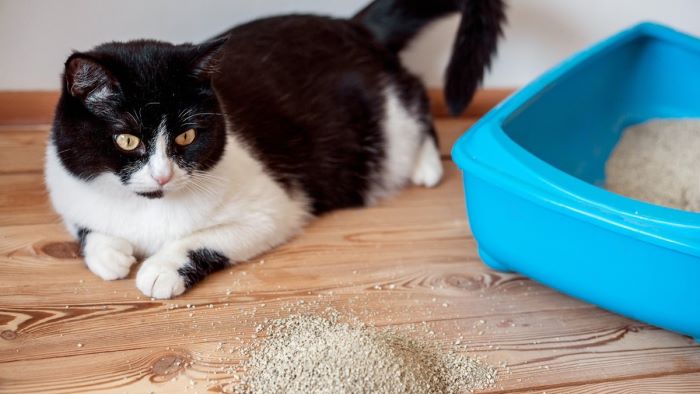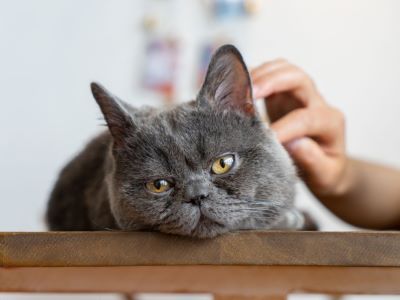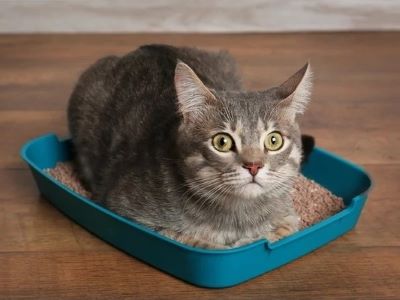Cats are naturally clean creatures and usually have no difficulty using their litter box. However, when a feline experiences a urinary tract infection (UTI), they may become reluctant or even refuse to use the litter box altogether.

UTIs can be uncomfortable and painful for cats, leading them to connect the litter box with distress and negative experiences. In this article, we will explore what a UTI is, how it can influence litter box behavior, and provide steps for retraining your cat to use the litter box after experiencing a UTI.
Contents
What Is an UTI, and How Does It Affect Litter Box Behavior?
NaturalVetcare Stated “FLUTD or Feline Lower Urinary Tract Disease describes a group of conditions that affect the bladder and urethra of cats.” A urinary tract infection (UTI) is a common yet potentially serious infection that affects the urinary system. UTI are particularly prevalent in female cats and can be caused by a range of factors, including bacteria, stress, or inadequate hygiene.
Symptoms of a UTI in cats may include frequent urination, pain or discomfort while urinating, and the presence of blood in the urine. Left untreated, UTIs can lead to more severe health complications.

When a cat experiences a urinary tract infection (UTI), they may become hesitant or even refuse to use the litter box. This is because the act of urinating can be painful and uncomfortable, causing the cat to associate the litter box with these unpleasant sensations.
Furthermore, cats may also avoid the litter box if it is not kept clean or if it is situated in an area that is too noisy or stressful for them to feel comfortable.
Steps for Retraining a Cat To Use the Litter Box
If your feline is suffering from a urinary tract infection (UTI) and is having difficulty using the litter box, there are several steps you can take to help them get back on the right track. These include:
- Make sure the litter box is clean and easily accessible: Cats are naturally clean animals and may be less likely to use a dirty litter box. Make sure to clean the litter box regularly and keep it in a location that is easily accessible to your cat.
- Gradually reintroduce the litter box into your cat’s routine: If your feline friend has been shying away from the litter box, start by adding a small amount of litter and gradually increasing it over time. This will help your cat become accustomed to the litter box again and make it a part of their daily routine.
- Encourage the cat to use the litter box: Place your cat in the litter box after meals or when they show signs of needing to go (e.g. sniffing around). You can also try using treats or praise to encourage your cat to use the litter box.

- Gradually transition back to your cat’s preferred type of litter: If your feline friend has a particular type of litter they prefer, try transitioning back to it gradually over time. This will help your cat become more accustomed to using the litter box again and make the process smoother.
- Consult with a veterinarian or a professional animal behaviorist: If your cat is having difficulty using the litter box after you have tried the suggested steps, it may be beneficial to consult with a veterinarian or professional animal behaviorist for additional guidance and support. They can help identify the underlying cause of their issue and develop a plan to help them adjust back to using the litter box.
FAQs
How do I know if my cat has a UTI?
Symptoms of a UTI in cats may include frequent urination, pain while urinating, and blood in the urine. If you suspect your cat may have a UTI, it is important to consult with a veterinarian for proper diagnosis and treatment.
Why is my cat avoiding the litter box?
There can be a multitude of explanations for why a cat may avoid its litter box, such as a urinary tract infection, an unclean litter box, or a stressful or loud environment. According to Catsan ”Sometimes a cat will avoid a litter tray because they’re not happy with where it has been positioned.” It is essential to consider all potential causes and address any underlying issues.
How can I encourage my cat to use the litter box again?
Some strategies for encouraging a cat to use the litter box again include placing them in the litter box after meals or when they show signs of needing to go, using treats or praise to reward them for using the litter box, and gradually transitioning back to their preferred type of litter.
Can I use any type of litter for retraining my cat?
It is generally best to use the type of litter that your cat is most familiar with and comfortable using. If your cat has a preferred type of litter, try gradually transitioning back to it over time.
Conclusion
Retraining a cat to use the litter box after experiencing a urinary tract infection (UTI) can be a daunting task, but with patience and consistency, it is achievable.
Ensuring the litter box is clean and easily accessible, gradually reintroducing it into the cat’s routine, encouraging the cat to use it, and transitioning back to their preferred type of litter can help your feline get back on track.
If you are having difficulty getting your cat to use the litter box, do not hesitate to seek advice from a veterinarian or a professional animal behaviorist for additional guidance and support.
Reference:
- Urinary tract infection and subclinical bacteriuria in cats: A clinical update. (2019, October 10). Retrieved December 24, 2022, from https://doi.org/10.1177/1098612X19880435
- Feline bacterial urinary tract infections: An update on an evolving clinical problem. (n.d.). Retrieved December 24, 2022, from https://doi.org/10.1016/j.tvjl.2009.12.006
- Weese, S. J. (2011, June 27). Antimicrobial Use Guidelines for Treatment of Urinary Tract Disease in Dogs and Cats. https://doi.org/10.4061/2011/263768
- Feline Lower Urinary Tract Disease. (2021, March 18). Animal Health Topics / School of Veterinary Medicine. https://healthtopics.vetmed.ucdavis.edu/health-topics/feline-lower-urinary-tract-disease
Charlene Pare is the founder of Cat Likes Best. She manages and strategizes the content published on this website. When she isn’t working, she enjoys exploring the city around with her Ameican Shorthair kitty–Moli. Being a technocrat and an avid cat lover, she also writes on pet tech products and some of the featured articles.





